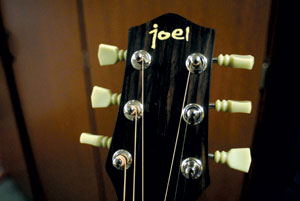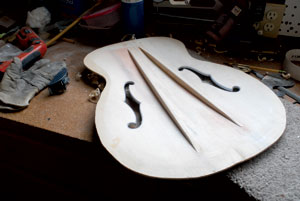Joel Knadler always wanted a Fender Telecaster Thinline guitar. But they’re not cheap.
So he thought outside the box.
“I made one,” Knadler said.
Knadler is a Columbia Falls Junior High School band teacher by day and a high-end, custom guitar maker by evening. Then, by night, he’s a rock star – or jazz star if you will. Conveniently, Knadler doesn’t have to worry about whether his guitars will produce the sound he wants when he’s onstage. He made the guitars – they sound exactly like he wants them to.
The first time he played his homemade Telecaster with its T-90 pickup, he knew it wasn’t a jazz guitar. It was born for the blues.
“It wasn’t mellow,” he said. “It just kind of wanted to scream and howl.”
Knadler works on guitars, mostly acoustic, almost daily in his shop after school: sawing, sanding, chiseling and experimenting. Lots of experimenting. He tries out different woods, alternating between maple, mahogany, walnut and always spruce for the soundboards on his acoustic guitars.
With all of his experimenting, a few guitars haven’t turned out quite like he intended. Those ones are reserved for teaching, where kids, who generally don’t detect the subtleties in intonation that Knadler does, can freely pluck away at them.
 |
|
Joel Nadler’s name is inscribed across the head of each of his guitars. |
“It takes as much work and time to make a bad guitar as it takes to make a good one,” Knadler said.
Knadler adheres to an experimental philosophy because he’s still relatively new to lutherie, the craft of building stringed instruments. Knadler said he has played music for most of his life and earned a master’s degree in music from Portland State University. He always enjoyed tinkering with guitars, adding and subtracting parts, but never actually made a guitar from scratch until he attended the American School of Lutherie in Portland three years ago.
After finishing those classes, Knadler bought the basic tools he needed for a shop and built 13 or 14 guitars within a year. Each guitar takes up to 60 hours of intricate craftsmanship. They took longer in the beginning. He tries to build as much as his already busy schedule allows. He’s still amused by being the sole instigator of a process that transforms a pile of boards into a finely crafted guitar.
“It’s like an addiction,” he said.
With his job at Columbia Falls Junior High, Knadler said he often serves the role of “circus ringleader,” rounding up herds of pre-teens and trying to teach them the intricacies of fine music. But he’s been teaching for 20 years and takes the responsibility on with glee. When the last school bell rings, though, Knadler has a few hours to himself, free to dabble in his shop.
His shop looks like that of any woodworker, with a variety of table saws, presses and sanders, along with hand tools. But a few things separate it from the regular carpenter’s workplace, most notably the guitar “carcasses” lying around. It’s clear he’s not making cabinets.
Like other woodworkers, Knadler cares about good wood. He likes to use walnut and maple as much as possible for the backs and sides of acoustic guitars, which is rare in a craft that relies heavily on East Indian Rosewood. Walnut and maple are “plentiful and affordable,” Knadler said. For the soundboard, or front of the acoustic guitar, he uses variations of spruce.
 |
|
The top plate, or “soundboard,” for Joel Knadler’s first attempt at an archtop guitar rests on his workbench in his shop off Helena Flats Road. |
“I really like American wood,” he said.
Using boards ranging from one-eighth to three-sixteenths of an inch thick, Knadler saws the wood into suitable sizes for each part of the guitar: sides, back, soundboard and neck. Then for the siding, which gives a guitar its gentle rolling form, he shapes the wood in a press, moistens it and heats it briefly at temperatures up to 500 degrees. Then he puts it into a clamp so it holds its shape and he can begin joining it with the rest of the guitar’s body. Plenty of chiseling, sanding and tinkering follows.
Also, there’s plenty you can’t see. The guts of the guitar – its braces and empty spaces that help determine the resonance of its sound – are vital to the instrument’s composition.
“A hundred little jobs end up being a guitar,” he said.
Knadler’s goal is to slip into a comfortable routine of making 12 guitars a year, one per month. On his Web site, www.joelguitars.com, the base price for his custom-made acoustic guitars is $2,400. Every dollar he makes right now goes back into the shop, which is constantly expanding, he said.
He can’t handle making many more than 12 guitars per year right now because of his teaching job, but that may change in the future. Also, he stays busy with gigs, playing for a few local groups, including the Nova Combo, a jazz quartet that recently recorded an album.
“In a couple of years or less I’d like to do it full-time, but right now I’m happy,” Knadler said.